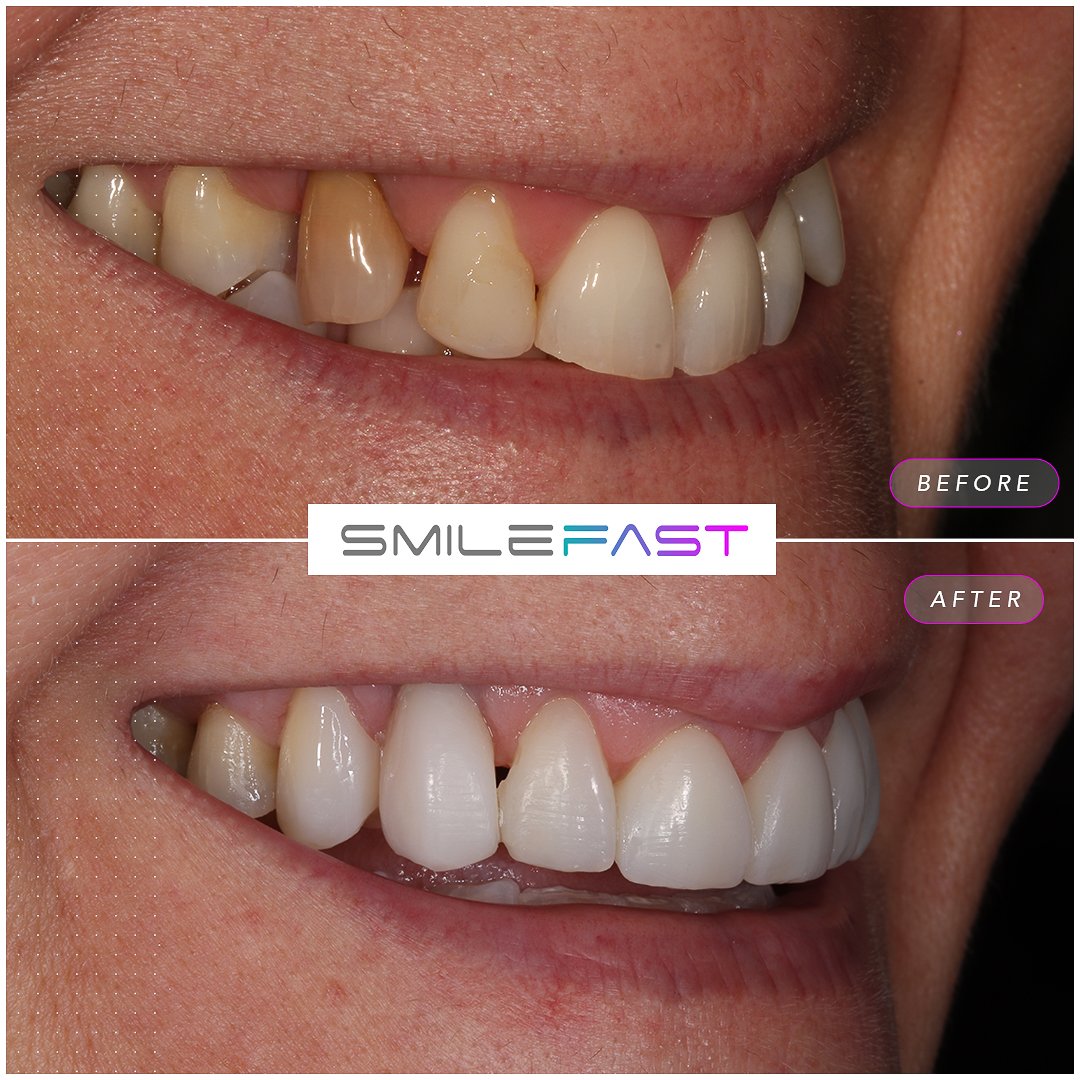Smilefast® Composite Bonding
Stockbridge Dental Practice provides Smilefast® Composite Bonding in their dental practice in Stockbridge, Edinburgh. This form of cosmetic treatment is a minimally invasive procedure that can create a great result within one or two visits to the dental practice. It is a quick and effective way of fixing minor cosmetic issues to help give you that perfect smile at an affordable price.
What is Dental Composite Bonding?
It's a form of dental bonding that helps fix minor damage to teeth including chipped teeth, the space between teeth, tooth discolouration and worn or misshapen teeth. By building up subtle layers of bonded composite resin, the bonding process creates the look of real tooth enamel.
Your dentist will assess what needs fixed based on the shape and colour of your teeth, how long it will take and the price of your composite veneer treatment using a clinical evaluation sheet. In the consultation, your dentist will take photos, X-rays and digital scans, or a dental impression of your teeth to create the most appropriate dental plan for you. The consultation takes about 45 minutes.
The Composite Bonding Procedure
The bonding procedure is pain free.
A colour match will be made to ensure they seamlessly fit with the agreed colour of your teeth. We will then assess the situation before gently positioning the Smilefast® stent over the teeth. This dental putty is shaped on the tooth to hold the composite in place, checking that the putty around the front teeth is seated fully onto the gums, before hardening the composite with a curing light. This activates the composite, which will then harden and sets as a durable resin, it takes about 60 to 90 minutes for each tooth to harden.
Your dentist will then go through a smoothing and polishing procedure so you can really see the benefits of this effective cosmetic dentistry.
How do I care for my composite bond?
Avoid anything that will stain your teeth like coffee, tea, various juices, dyed food stuffs and smoking for 48 hours after your bonding treatment.
Your oral health matters to us. By regularly attending hygienist visits, your composite bond can be checked to ensure they are still unstained. If you are wondering how long does composite bonding last for? your composite bond could last for up to 10 years, but dietary and lifestyle choices may limit the longevity of the effect.
Crowns and veneers do last longer. If your teeth were chipped through bad habits like chewing pens or crunching on hard candy; do try avoid the bad habit! We can help you improve your teeth hygiene by speaking to our experienced team at the dental practice.
Do all the usual teeth cleaning procedures. Brush your teeth twice a day, but not too vigorously. Use a good toothbrush and good toothpaste and floss your teeth once a day. Your dentist or hygienist can help show you what to do to get the most of this simple daily procedure.
Composite Bonding Pros and Cons:
- Minimally invasive – maintains most of the natural tooth structure
- Cheaper to repair than porcelain – can bond directly to existing tooth or composite
- Overall treatment cost less than porcelain
Tooth bonding is an excellent, inexpensive way to repair teeth that are damaged or have had decay. A composite resin is chosen to match a patient's natural tooth colour and the material is bonded directly to the tooth that needs repairing.
Sometimes the change only needs to be minor to make a massive impact on your smile. In other cases, the whole tooth needs to be covered over – this is known as a ‘composite veneer’.
It goes without saying, following the treatment your smile is going to look much more aesthetically appealing. You’ll feel confident to show your teeth in photos and share your smile with friends and family. This will push through to the wider benefits of increased confidence.
- It’s much faster than teeth straightening options, for example. Whether it is an alternative will depend on how your teeth are currently positioned though. It is also particularly safe due to the fact that no preparation is usually needed and the treatment is non-invasive.
Composite Bonding after Orthodontic Treatment
Unfortunately, not all of us are born with perfectly straight teeth. When the teeth are in the wrong position, they wear in different areas. After orthodontic treatment such as Invisalign, the teeth become straight, the wear-and-tear sometimes becomes more prominent. Composite Bonding helps build up the teeth once the braces are off. This enables us to give you the perfect teeth and smile makeover once the teeth are in the correct position. It’s that finishing touch which can make all the difference!
The Cost
Smilefast® Composite bonding is an inexpensive solution in comparison to many health care costs, ranging from to £100 –£2800 . A precise cost can only be evaluated after the initial evaluation.
If you need to talk about Finance, Dental Patient Plans, Tooth whitening, getting a Filling, Crowns, Teeth Cleaning, Implants and more, please just get in touch.
Your Dentist
Your dentist is qualified as a Smilefast® composite bonding specialist in Edinburgh that is trained to ensure you get the desired outcome of this cosmetic treatment. Check out the dental team page and read their credentials and book an appointment with the clinic.
-
Composite bonding is classically the term used for any white filling but is now often associated with cosmetic repairs to the front teeth using composite filling material. This can either consist of small repairs to the edges of chipped enamel up to full coverage composite veneers.
-
Composite edge bonding is smaller repairs using the same colour of composite as your teeth. It is often used in combination with tooth whitening and tooth straightening treatments. The aim is to improve the shape or length of the teeth if they are out of line, chipped or uneven. Composite veneers tend to be used to make bigger changes to the teeth including the shape, size, colour and position. It is normally carried out with a full smile design and often used in combination with tooth whitening and tooth straightening treatments.
-
We recommend booking a consultation to discuss the different treatment options available and assess suitability for treatment. You need to be dentally healthy before proceeding so we also recommend seeing the hygienist before commencing treatment.
-
We will carry out a full dental health assessment to make sure everything is healthy to proceed. We will also take photos, scans and sometimes X-rays of your teeth to explore the different treatment options to decide the best treatment for each person
-
As with any dental restoration the composite bonding will not last forever and will need maintenance in the future. The average lifespan of composite bonding is 3-5 years but will often last much longer than this.
-
The lifespan of the composite bonding will be improved if it is looked after well. This includes a home care routine of brushing twice daily and interdental cleaning using interdental brushes or floss.
We also recommend seeing the hygienist regularly to maintain gum health, getting the composite bonding polished at least once per year and will often recommend a retainer or mouth guard to protect your composite bonding during sleep
-
Composite bonding is completely additive so your teeth will not be damaged but in cases of repairing broken teeth they might be polished slightly to remove sharp edges.
-
The shade of composite bonding is selected ahead of treatment so the colour can not be changed after placement. However, hygienist visits and tooth whitening can be used to lift any stains from the composite bonding to return it to the original shade. If you are thinking about tooth whitening then we would recommend doing this before composite bonding.
-
If we have done the composite bonding for you then we will have all your records already so you can call us and we will see you as soon as possible to repair the composite bonding. If you have had the composite bonding elsewhere, we are happy to help but we would encourage you to get a copy of any records from the clinic that provided the treatment e.g moulds, models or a record of the composite used, as this may be needed before providing any necessary treatment.






